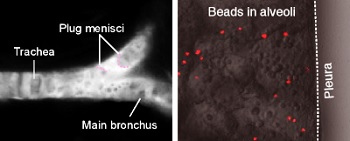 |
| A small liquid plug in the bronchus is manipulated by air ventilation to deliver a drug into the most distant alveoli.--Courtesy of Columbia U. |
A team of researchers at Columbia University has developed a method of drug delivery to the lungs that could lead to more efficient dosing for many kinds of lung diseases using microvolume liquid concentrations. By delivering drugs directly to the disease site, treatment can be relegated to the necessary areas without causing dangerous side effects in other nearby organs.
To create a technique for delivering the liquid drugs to the far reaches of the lungs, the team first had to study how, in fact, liquid travels through the complex structures of the lungs, from the large bronchus to the tiny alveoli. Using glass tubes with liquid "plugs," the team developed a mathematical model to demonstrate how the liquid is transported from larger to smaller generations of the lung structure. They used that model to then predict the way liquid would move in ventilated lungs, capturing images that confirmed their hypothesis.
Among the diseases the liquid dosing could someday treat are cystic fibrosis, bronchopneumonia, chronic obstructive pulmonary disease and lung cancer, which are often treated currently with oral or aerosol application, which can lead to overdosing.
"We envision that our micro-volume liquid instillation approach will enable predictable drug concentrations at the target site, reducing the amount of drug required for effective disease treatment with significantly reduced side effects," lab supervisor Gordana Vunjak-Novakovic said in a statement. "The lung is a hugely complex organ that has billions of cells within a hierarchically organized tissue that cannot be built from scratch. Four years ago, we started research of lung regeneration using stem cells and bioengineering methods. And we continue to work with our clinical colleagues to develop new treatment approaches for treating lung disease."
The team comprised a number of different concentrations, requiring the collaboration of several biomedical engineers, a lung transplant surgeon and a pulmonologist. Postdoctoral fellow Jinho Kim in particular, the lead author of the study, developed the mathematical model on which the approach is based.
"Liquid instillation has been used for providing lung surfactant to the entire lungs in premature infants who cannot produce enough surfactant to breathe normally," Kim said. "Although liquid instillation has great therapeutic potential, its applications have been unexplored, largely because of limited understanding of the liquid transport in the lung airways. We are very excited about the implications of our work."
- here's the Columbia report